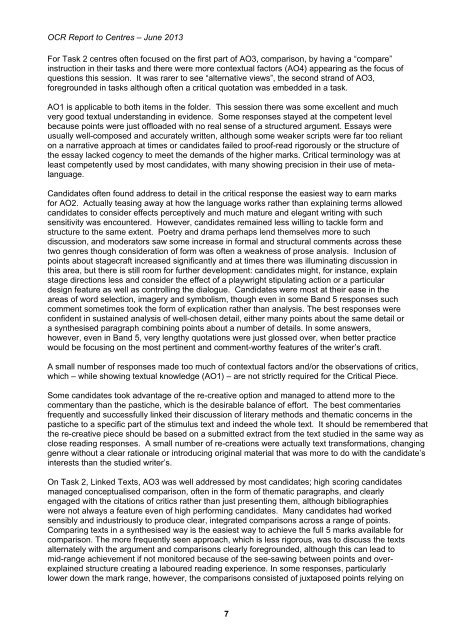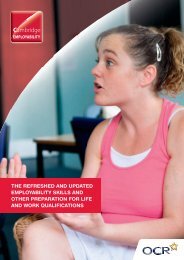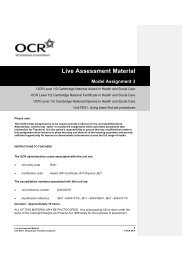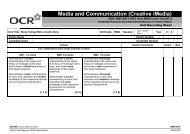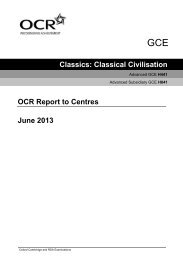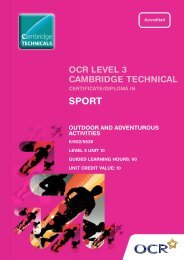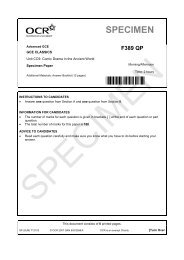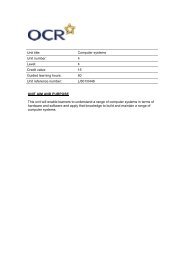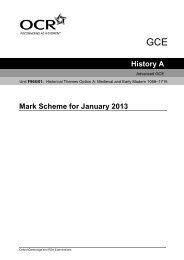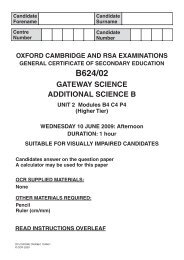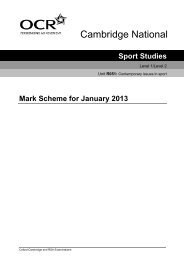Examiners' reports - June (PDF, 385KB) - OCR
Examiners' reports - June (PDF, 385KB) - OCR
Examiners' reports - June (PDF, 385KB) - OCR
Create successful ePaper yourself
Turn your PDF publications into a flip-book with our unique Google optimized e-Paper software.
<strong>OCR</strong> Report to Centres – <strong>June</strong> 2013<br />
For Task 2 centres often focused on the first part of AO3, comparison, by having a “compare”<br />
instruction in their tasks and there were more contextual factors (AO4) appearing as the focus of<br />
questions this session. It was rarer to see “alternative views”, the second strand of AO3,<br />
foregrounded in tasks although often a critical quotation was embedded in a task.<br />
AO1 is applicable to both items in the folder. This session there was some excellent and much<br />
very good textual understanding in evidence. Some responses stayed at the competent level<br />
because points were just offloaded with no real sense of a structured argument. Essays were<br />
usually well-composed and accurately written, although some weaker scripts were far too reliant<br />
on a narrative approach at times or candidates failed to proof-read rigorously or the structure of<br />
the essay lacked cogency to meet the demands of the higher marks. Critical terminology was at<br />
least competently used by most candidates, with many showing precision in their use of metalanguage.<br />
Candidates often found address to detail in the critical response the easiest way to earn marks<br />
for AO2. Actually teasing away at how the language works rather than explaining terms allowed<br />
candidates to consider effects perceptively and much mature and elegant writing with such<br />
sensitivity was encountered. However, candidates remained less willing to tackle form and<br />
structure to the same extent. Poetry and drama perhaps lend themselves more to such<br />
discussion, and moderators saw some increase in formal and structural comments across these<br />
two genres though consideration of form was often a weakness of prose analysis. Inclusion of<br />
points about stagecraft increased significantly and at times there was illuminating discussion in<br />
this area, but there is still room for further development: candidates might, for instance, explain<br />
stage directions less and consider the effect of a playwright stipulating action or a particular<br />
design feature as well as controlling the dialogue. Candidates were most at their ease in the<br />
areas of word selection, imagery and symbolism, though even in some Band 5 responses such<br />
comment sometimes took the form of explication rather than analysis. The best responses were<br />
confident in sustained analysis of well-chosen detail, either many points about the same detail or<br />
a synthesised paragraph combining points about a number of details. In some answers,<br />
however, even in Band 5, very lengthy quotations were just glossed over, when better practice<br />
would be focusing on the most pertinent and comment-worthy features of the writer’s craft.<br />
A small number of responses made too much of contextual factors and/or the observations of critics,<br />
which – while showing textual knowledge (AO1) – are not strictly required for the Critical Piece.<br />
Some candidates took advantage of the re-creative option and managed to attend more to the<br />
commentary than the pastiche, which is the desirable balance of effort. The best commentaries<br />
frequently and successfully linked their discussion of literary methods and thematic concerns in the<br />
pastiche to a specific part of the stimulus text and indeed the whole text. It should be remembered that<br />
the re-creative piece should be based on a submitted extract from the text studied in the same way as<br />
close reading responses. A small number of re-creations were actually text transformations, changing<br />
genre without a clear rationale or introducing original material that was more to do with the candidate’s<br />
interests than the studied writer’s.<br />
On Task 2, Linked Texts, AO3 was well addressed by most candidates; high scoring candidates<br />
managed conceptualised comparison, often in the form of thematic paragraphs, and clearly<br />
engaged with the citations of critics rather than just presenting them, although bibliographies<br />
were not always a feature even of high performing candidates. Many candidates had worked<br />
sensibly and industriously to produce clear, integrated comparisons across a range of points.<br />
Comparing texts in a synthesised way is the easiest way to achieve the full 5 marks available for<br />
comparison. The more frequently seen approach, which is less rigorous, was to discuss the texts<br />
alternately with the argument and comparisons clearly foregrounded, although this can lead to<br />
mid-range achievement if not monitored because of the see-sawing between points and overexplained<br />
structure creating a laboured reading experience. In some responses, particularly<br />
lower down the mark range, however, the comparisons consisted of juxtaposed points relying on<br />
7


